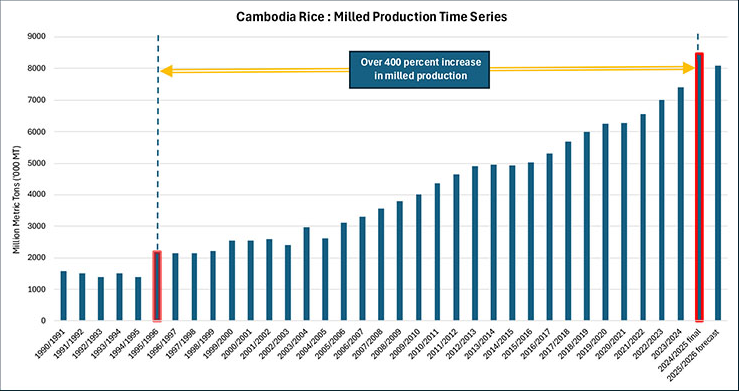Tags
Kingdom’s milled rice production surges by 400% since mid-1990s
Sreekanth Ravindran / Khmer Times

Synopsis: Cambodia exports nearly half of their rice production and is ranked fifth among the global rice exporters, the US report says.
The Kingdom’s rice production has increased by 400 percent since the mid-1990s, owing to the exploration of advanced technologies, better infrastructure, scientific cropping methods and the use of genetic variants, the Commodity Intelligence Report recently released by the Foreign Agriculture Service in the US Department of Agriculture says.
The report also underscores that the area under paddy cultivation has grown by 108 percent across the Kingdom when 1990 is taken as a base year.
Although the Cambodian population consumes rice daily, the report said Cambodia exports nearly half of their rice production and is ranked fifth among the global rice exporters.
“Some of the driving factors that led to the rice productivity boom were modernisation, expansion of market opportunities, and the end of decades-long political instability.
“Modernisation was introduced to Cambodia’s rice value chain as a support mechanism that enabled the rice sector to achieve higher productivity. Investments in land expansion, enhanced farming practices, and new seed technologies were widely adopted, leading to an increase in rice sown area.
“Though rice is produced along the Tonle Sap Lake, the main rice-producing provinces are situated at the southern and northeastern borders.
“Prey Veng is the nation’s largest rice-producing province, accounting for roughly 13 percent of production, followed by Takeo, Battambang, and Banteay Meanchey at 11 percent, 11 percent, and nine percent, respectively.”
The report emphasised that Cambodian rice is cultivated year-round, in two distinct growing seasons: a wet season crop followed by a dry season crop. “In the wet season, which is Cambodia’s primary crop period, rice can achieve three sowing cycles. The names of these three cycles are associated with the rice variety and duration for each growing cycle, which is short (90-to-110-day growth period), medium (120-to-150-day growth period) and long-term (155 or longer day growth period).
“Sowing for the wet season crops begins in May to June. Harvest typically occurs from August to September for short and medium-term varieties and October to January for long-term varieties.
“In the dry season, which is Cambodia’s secondary crop period, rice typically achieves one sowing cycle due to lack of water availability. Sowing begins in November to December, with harvest occurring from February to April.”
For the 2025/26 marketing year (MY), the US Department of Agriculture estimates Cambodia rice production at 8.10 mmt (milled basis), down four percent from MY 2024/25. Harvested area is estimated at 3.80 mha, down two percent from MY 2024/25. Yield (rough basis) is estimated at 3.49 t/ha, down three percent from MY 2024/25.
“With the rice planting window for MY 2025/26 wet season underway, expectations of a normal rainfall pattern will benefit potential rice yields. Early prospects for rice yields are expected to be on par with the 10-year trend but still down from the MY 2024/25 record.
“Current unfavourable prices could result in farmers opting to plant more profitable crops, such as pineapple and other fruits. As a result, lower potential yield prospects and reduced rice harvested area are expected to lead to a decrease in national rice production.”
According to a preliminary forecast released by the Food and Agriculture Organisation (FAO), the aggregate paddy production in 2025/26 will reach 13.9 million tonnes (MT), which is about 10 percent above the five-year average.
In 2024/25, the aggregate paddy production in the country stood at 14.2 MT. Aggregate paddy production refers to the total volume or weight of paddy rice harvested across the country within a given period. It’s a measure of the overall output of the rice crop, accounting for all the different rice varieties and crops harvested in that region.
The FAO said planting of the 2025/26 main wet season paddy crop, accounting for about 70 percent of annual output, is expected to be finalised by the end of August.
An official Ministry of Agriculture, Forestry and Fisheries (MAFF) estimate, as of early August 2025, says that about 2.7 million hectares of land were planted with paddy, close to the record level reached in the same period in 2024.
https://www.khmertimeskh.com/501755044/kingdoms-milled-rice-production-surges-by-400-since-mid-1990s/Published Date: September 11, 2025






